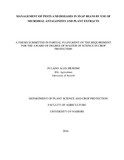| dc.description.abstract | Kenya’s snap bean export market share has been lost to other African and Central American
countries over the last five years as a result of interceptions due to presence of chemical residues
above acceptable levels. The objective of this study was to evaluate the effectiveness of local
antagonistic microorganisms and crude plant extracts against major pests and diseases of snap bean
as alternatives to synthetic pesticides. Laboratory in vitro studies were conducted to evaluate the
antifungal activity of microbials isolated from local environments while phytopathogenic fungi
were isolated from diseased plant tissues. Screening of antifungal activity of microbial isolates
against Fusarium solani, Colletotrichum lindemuthianum, Alternaria solani and Rhizoctonia solani
was carried out using the dual culture method. Diameters of the pathogens cultures were determined
and percentage growth inhibition calculated compared to controls. The active microbial isolates
were identified and data was collected at two day intervals.
Field studies were carried out to evaluate efficacy of the most effective antifungal antagonists from
in vitro studies as well as selected plant extracts from another related study. The antagonists
included Trichoderma viride, T. harzanium, T. asperellum and Paecilomyces sp. while crude plant
extracts were from turmeric, garlic, ginger and lemon. Field experiments were set up in farmer's
field in Mwea for two cropping seasons, short rains and long rains. The fungal antagonists were
multiplied on sterile sorghum grains while the crude plant extracts were prepared by blending plant
material in ethanol and concentrated by evaporation under vacuum. They were applied weekly as
foliar sprays, commencing one week after emergence until podding. Their efficacy was compared to
that of Dithane M-45®, Confidor 70 WG®, Trianum® (Trichoderma) and Achook® (neem).
A total of 42 microbial isolates were isolated from local environments of which 69%, 19% and 12%
fungi, bacteria and actinomycetes respectively that inhibited the mycelia growth of phytopathogens.
The 16 most promising antagonists were all fungi and the most efficacious were Paecilomyces spp.,
Trichoderma viride, T. asperellum and T. harzanium. Trichoderma harzanium was most active in
reducing mycelial growth of the test pathogens by up to 66%. The 16 fungal antagonists varied in
activity while the phytopathogens varied in sensitivity over time. In field experiments, antagonistic
fungi and crude plant extracts significantly (P ≤ 0.05) reduced the population of whitefly and thrips.
The crude plant extracts reduced the population of whitefly and thrips by up to 58% and 41% with
corresponding reduction by antagonistic fungi of up to 30% and 18%, respectively. These
treatments significantly reduced the disease index of angular leaf spot, anthracnose and rust.
Antagonistic fungi and crude plant extracts reduced disease index by up to 50.9% and 33.5%,
respectively. In addition, they significantly increased pod yield and reduced the pest and disease
damaged pods. The results demonstrated that local environment has a great potential as sources of
biologically active antagonistic microorganisms and plant-based compounds that can be exploited
for integrated management of insect pests and diseases in snap bean production. This would reduce
chemical residues and therefore enable the local growers of snap beans access the more lucrative
export markets. | en_US |



